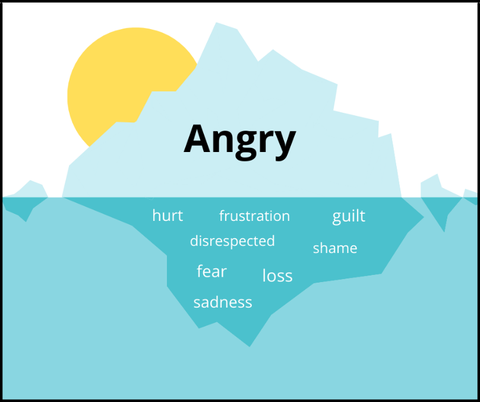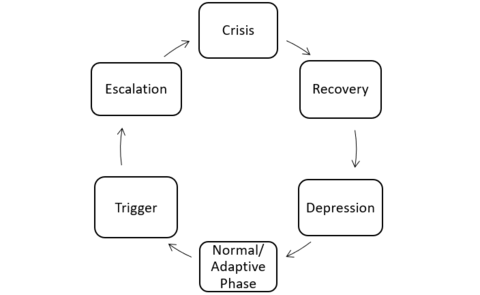Your Quick Guide to Anger Management in the Workplace
Anger is complex and often a misunderstood emotion that goes beyond simply being mad. Anger is a natural response that follows phases and can transpire from many factors, including other hidden feelings.
Anger Management training in the workplace can help employees increase their self-awareness and self-management when it comes to anger. It can positively contribute to employee morale, conflict resolution, and creating an overall improved workplace culture.
Myth Busting: Common myths about anger, debunked
Anger is a complicated emotion that brings up many different associations and assumptions in people's minds. For clarity, below are some common myths about anger, debunked:
- "Anger needs to be 'unleashed' for it to go away." - Anger indeed needs to be expressed to relieve symptoms. However, expressing anger in verbally or physically aggressive ways is not the only way to 'unleash' anger. Nor is anger an excuse for a person to be aggressive. The expression of anger can be tempered by rationality and forethought. Venting anger does not necessarily result in the anger disappearing, although venting can relieve the symptoms. At times, processing personal experiences, seeing concrete change, and genuine forgiveness are needed for anger to go away.
- "Ignoring anger will make it go away." - Generally, all kinds of emotions do not disappear when ignored. The anger just gets temporarily shelved and will likely find other ways of getting expressed. It can get projected to another person, transformed into a physical symptom, or built up for a more significant future blow-up. Some of our behaviours may even be unconscious ways of expressing anger. While there are situations when it's inadvisable to express your rage immediately, the very least you can do is acknowledge that it exists.
- "You can't control your anger." - This myth is related to the second one. As discussed earlier, the fight and flight instinct can make anger an overwhelming emotion. However, this instinct does not mean that you're but a slave to your impulses. Awareness of anger dynamics and a conscious effort to rise above your anger can help you regain control of your reactions.
- "If I don't get angry, people will think I am a pushover."'- It's true that a person can lose credibility if they make rules and then ignores violations. However, anger is not the only way a person can show that there are consequences to violations. The most effective way of instilling discipline in others is to have a calm, non-emotional approach to dealing with rule-breakers. Calm and rationality can communicate strength too.
Getting to the Root of the Anger
Anger is a normal response that is often experienced as a secondary emotion. This concept can be represented with the Anger Iceberg. The Anger Iceberg illustrates the idea that emotional reactions are not always one-dimensional; instead, there are many hidden causes. Although anger may be presented and expressed externally, other underlying emotions give energy to this anger.

Emotions that frequently prompt anger include:
- Frustration - When a goal is blocked from reaching the desired result, individuals will become frustrated. This frustration will provoke anger as an emotional response, directed at the object recognized as the cause of the frustration.
- Hurt/Loss - Individuals will turn to anger as a substitute for feeling pain. Anger is a normal stage during the grieving process. This can be done consciously or unconsciously.
- Disrespected - This occurs when individuals are not given the respect they deserve or feel that they are constantly under attack.
- Fear - Fear and anger derive from feelings of control; while fear will typically arise from a loss of control, anger is a means of gaining back control.
- Shame - Anger is used as a defense response when individuals perceive they are humiliated, criticized, or rejected. Anger is a way to distract us from feelings of shame.
- Guilt - Reacting with anger is used to protect our ego and remove ourselves from the blame. Unfortunately, this means that blame is taken from within and placed on another individual.
- Sadness - When we feel sad, we feel vulnerable and as though we have a loss of control. To avoid these feelings of sadness, we will subconsciously shift into an anger mode to mask feelings of disappointment or discouragement.
Anger: Understanding the Cycle
Anger is a natural emotion that usually stems from perceived threat or loss. It's a pervasive emotion; it affects our body, thoughts, feelings, and behaviour. Anger is often described in terms of its intensity, frequency, duration, threshold, and expression.
Anger typically follows a predictable pattern: a cycle. Understanding the cycle of anger can help us understand our own anger reactions and those of others. It can also help us in considering the most appropriate response.

- The Trigger Phase
The trigger phase happens when we perceive a threat or loss, and our body prepares to respond. There is a subtle change from an individual's normal/adaptive state into a stressed state in this phase. Anger triggers differ from person to person and can come from both the environment or our thought processes.
- The Escalation Phase
In the escalation phase, there is the progressive appearance of the anger response. In this phase, our body prepares for a crisis after perceiving the trigger. This preparation is primarily physical and manifests through rapid breathing, increased heart rate, and raised blood pressure. Once the escalation phase is reached, there is less chance of calming down, as this is the phase where the body prepares for fight or flight.
- The Crisis Phase
As previously mentioned, the escalation phase is progressive, and it is in the crisis phase, the anger reaction reaches its peak. In the crisis phase, our body is on full alert, prepared to take action in response to the trigger. During this phase, logic and rationality may be limited, if not impaired, because anger takes over. In extreme cases, the crisis phase means that a person may be a severe danger to himself or other people.
- The Recovery Phase
The recovery phase happens when the anger has been spent or at least controlled, and there is now a steady return to a person's normal/ adaptive state; in this stage, reasoning and awareness of one's self returns. If the proper intervention is applied, the return to normalcy progresses smoothly. However, an inappropriate intervention can reignite the anger and serve as a new trigger.
- The Depression Phase
The depression phase marks a return to a person's normal/ adaptive ways. Physically, this stage marks below normal vital signs, such as heart rate, so that the body can recover equilibrium. A person's full use of his faculties returns at this point, and the new awareness helps a person assess what just occurred. Consequently, this stage may be marked by embarrassment, guilt, regret, and or depression.
After the depression phase is a return to a normal or adaptive phase, a new trigger can start the entire cycle repeatedly. Some people also skip certain phases, or else they go through them privately and/or unconsciously.
Controlling Anger: Actionable Steps
Since anger is an instinctive emotion that comes unbidden, we often do not have a choice in whether we would be angry or not. What we can do, however, is take control of our anger when it comes. Anger management is not about suppressing your feelings of anger but rather finding meaning behind your anger and determine healthy ways to express this anger. Uncontrolled anger can be extremely problematic; thus, it is essential to find strategies to keep anger in check. The more you practice the strategy of gaining control over your anger, the easier it will become.
Relaxation techniques to control anger include:
- Breathing Exercises - Deliberately controlling your breathing can help a person calm down. Ways to do this include: breathing through one's nose and exhaling through one's mouth, breathing from one's diagram, and breathing rhythmically.
- Meditation - Meditation is a way of exercising mental discipline. Most meditation techniques involve increasing self-awareness, monitoring thoughts, and focusing. Meditation techniques include prayer, the repetition of a mantra, and relaxing movement or postures.
- Progressive Muscle Relaxation (PMR) - PMR is a stress management technique that involves mentally inducing your muscles to tense and relax. PMR usually focuses on areas of the body where tension is commonly felt, such as the head, shoulders, and chest area. It's a way to exercise the power of the mind over the body.
- Visualization - Visualization is the use of mental imagery to induce relaxation. Some visualization exercise involves picturing a place of serenity and comfort, such as a beach or a garden. Other visualization exercises involve imagining the release of anger in a metaphorical form. An example of this latter kind of visualization imagines one's anger as a ball to be released to space.
- Music - Some people find listening to music very relaxing. The kind of calming music differs from person to person; traditional relaxation music includes classical pieces, acoustic sounds, and even ambient noises.
- Art and Crafts - Some people find working with their hands as a good way to relax. It is especially true for people who feel their tensions in their hands. Drawing pictures, paper construction, and sculpting are just some of the ways to de-stress when faced with an anger trigger. Arts and crafts are helpful because it keeps a person from obsessing on the anger while they are still in the recovery phase of the anger cycle.
Conclusion
Anger management is a process. It is impossible to remove anger from our lives, but finding healthy outlets for this anger is possible. Anger management involves being informed, self-awareness, taking control, and taking action. These changes take time and practice; however, when you stay motivated by controlling your anger, you will have powerful, positive outcomes.
Did you enjoy our anger management quick guide? We've just updated our Anger Management course, making it more relevant than ever for your participants. There's no better time to tackle anger management training in your organization. Learn more about this course or get started on your training today.
Posted by Katelyn Roy on June 24, 2021
